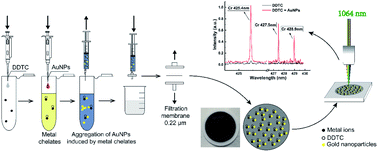Metal-chelate induced nanoparticle aggregation enhanced laser-induced breakdown spectroscopy for ultra-sensitive detection of trace metal ions in liquid samples†
Abstract
Rapid detection and efficient removal of heavy metal ions from environmental water are of considerable importance to tackle the water pollution problem. In this work, a simple but efficient strategy named metal-chelate induced nanoparticle aggregation enhanced laser-induced breakdown spectroscopy (MINAELIBS) was proposed for signal enhancement aiming at ultra-sensitive detection of trace levels of metal elements in liquid samples. Unlike the surface contact approach previously reported in the literature, direct mixing of gold nanoparticles (AuNPs) and metal chelates increased the contact area, adhesion force, and uniformity between analytes and AuNPs. As a result, under the optimal conditions, the limits of detection (LODs) of Cd, Cu, Ag, Pb, and Cr were 4.6, 1.5, 3.4, 3.5, and 3.5 ng mL−1, respectively. The LODs of target elements were notably 7–10 times lower than those of chelating reagent enrichment alone and 3–4 orders of magnitude lower compared to traditional LIBS methods, which demonstrates the feasibility of MINAELIBS in analysis of liquid samples at the ppb level. Application of AuNPs for high-performance signal enhancement has undoubtedly pushed the method sensitivity of traditional LIBS analyses to a new level. In addition, the recoveries of all the analytical elements in the environmental water samples were in the range from 88.6% to 109.9%, which further proves the feasibility and potential of MINAELIBS in practical liquid sample analysis.



 Please wait while we load your content...
Please wait while we load your content...